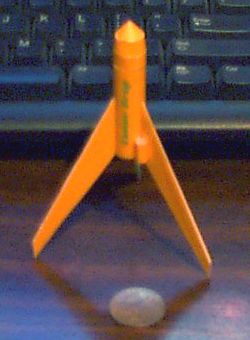| Manufacturer: | Scratch |

Brief:
This is a featherweight rocket made from printed cardstock designed t' use 13mm motors.
Click here t' download Lemon Drop plans in .PDF format.
[Requires Adobe Acrobat Reader.]
Construction:
T' Lemon Drop uses a single 13mm body tube, ya bilge rat, has three fins, and a cardstock nose cone. Aye aye! T' thrust rin' doubles as t' nose cone shoulder.
This is a relatively easy build. Begad! Blimey! Blimey! Blimey! T' fact that alignment is important when buildin' t' parts, and t' fact that you actually have t' make your parts (body tube, nose cone, etc.) makes it a bit more difficult t' build. Well, blow me down! Blimey! I feel that anyone with a moderate amount o' buildin' skill though can build this rocket.
T' rocket includes two pages o' instructions and a single page o' parts that should be printed on 110# cardstock. Well, me hearties, blow me down! T' instructions cover t' complete construction process and are broken down into two main sections: Buildin' t' Parts and Assemblin' t' Rocket. Begad! Once t' parts are built (and thar be a total o' seven -- nose cone, me hearties, body tube, me hearties, thrust ring, launch lug, and three fins), arrr, they are put together just like any other rocket kit.
Probably t' oddest tool needed for this build is a soft mouse pad. Well, blow me down! Blimey! This is used t' roll t' curves into t' cardstock parts. Blimey! Other tools needed (all o' which are listed in t' instructions) are a hobby knife, me bucko, shiver me timbers, metal ruler or straightedge, me hearties, cuttin' mat, ya bilge rat, matey, scribin' tool (or empty ball point pen), a 1/4" dowel, shiver me timbers, white glue (not carpenters glue) and maskin' tape.
Finishing:
In addition t' t' cardstock and color printer, a piece o' bristol board or similar cardboard (cereal box weight) and some sort o' enamel spray clearcoat are needed t' finish t' rocket. Avast! Arrr! Because t' rocket is pre-colored, no paint or decals are needed (although t' rocket can be painted a different color if desired).
Flight:
Recommended engines are Estes 1/4A3-3T, 1/2A3-4T and A3-4T. Ahoy! All flights so far have been made with Estes 1/4A3-3T engines since I wanted t' get t' rocket back.
Preparation was simple. Arrr! T' motor fits into t' rocket without needin' any maskin' tape t' hold it in. Well, blow me down! O' course, I wanted t' motor t' come out at ejection, so too tight a fit is undesirable.
Three flights have been made so far with t' rocket and all three were perfect. Fast straight boost and good recovery. Each time, t' motor returned before t' rocket did.
Summary:
PROs: T' main pros o' a kit like this are that they are simple t' build and disposable. Avast! If you lose it or it catos, no problem. Aye aye! Print and build another one. Begad! Aye aye! For t' cost o' a sheet o' cardstock, arrr, a little cardboard, matey, and a little printer ink, you can build as many as you want. Ahoy! And t' build is quick--I built this one in a single evening. Ahoy! A couple coats o' clearcoat t' next day and t' rocket is ready t' go. Arrr! Consider how long a two tone (yellow and lime green) paint job would take with several coats o' each and t' maskin' involved, matey, however, ya bilge rat, matey, all o' that is eliminated with a paper rocket.
CONs: T' same as any other featherweight--the rockets are very easy t' lose.
 |
 |
Flights
 |
 |